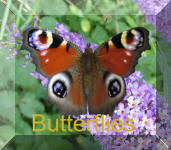BACK TO

The Grayling butterfly is superbly camouflaged as it rests on bare ground with its wings closed. The caterpillars feed on fine grasses and the adults fly in July and August. In south Cumbria the Grayling usually occurs on the open, limestone hills around Morecambe Bay where there is plenty of bare ground. Further north it is confined to the coast, where it inhabits open dry heath and dune systems.
The female of this species is larger and more brightly coloured than males . Bothe sexes have a habit when pursued of settling and briefly displaying the bright eye spots on the fore wing diverting attention from the body. The butterfly then slides its conspicuous forewings beneath the hind wings , so resembling its surroundings that it cant be seen. and making it appear smaller The Grayling then leans over at an anle to the sun thereby minimising the length of its shadow. Graylings are strong fast flyers on the wing from July to September .
Habitat
It visits stony , ground such as chalk and limestone hills ,heathland and sand dunes . It can be locally common.
Many colonies are coastal, on dunes, saltmarsh, undercliffs, and clifftops. Inland, colonies are found on dry heathland, calcareous grassland, old quarries, earthworks, derelict industrial sites such as old spoil heaps and, in a few areas, in open woodland on stony ground. It occurs on a range of soil but dry and well-drained, with sparse vegetation and plenty of bare ground in open positions.Foodplants
The main species used include Sheep's-fescue (Festuca ovina), Red Fescue (F. rubra), Bristle Bent (Agrostis curtisii), and Early Hair-grass (Aira praecox). Coarser grasses such as Tufted Hair-grass (Deschampsia cespitosa) and Marram (Ammophila arenaria) are occasionally used.
Eggs are depositted on grasses such as Sheeps Fescue. The larvae feed at night from September ( even at times through winter ), until the following June , when they pupate in coccons constructed under ground the only British Butterfly to do so.The Pupae are smooth , rich chocolate brown and plump and aults emerge after one month
